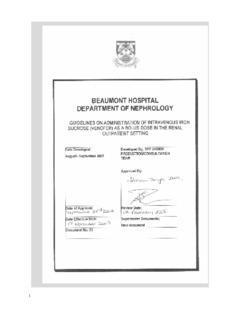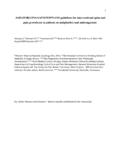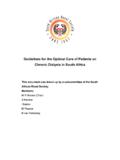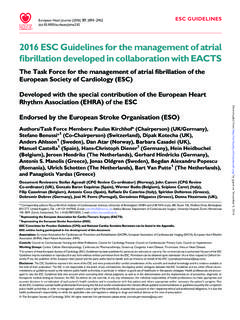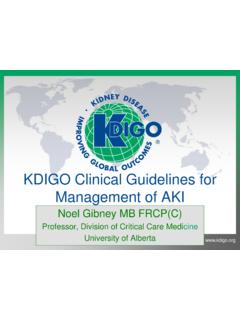Transcription of Anticoagulation guidelines for chronic and acute ...
1 Anticoagulation guidelines for chronic and acute hemodialysis patients 1 Anticoagulation guidelines for chronic and acute hemodialysis patients 2 Transplant, Urology & Nephrology Directorate Anticoagulation guidelines for chronic and acute hemodialysis patients Document Number: 19b Reason for Change: Update Original Date of Approval: June 2009 Originally Approved By: Renal Guideline Committee Recent Date of Approval:17th January 2012 Approved By: Renal guideline committee Date Effective From: January 2012 Superseded Documents: 19a Review Date: January 2014 Anticoagulation guidelines for chronic and acute hemodialysis patients 3 CONTENTS PAGE NO. 1) Section 1 Anticoagulant drugs 3 Rationale 3 Scope 3 Principles 3 2) Section 2 Roles and Responsibilities of the 4 medical and nursing personnel 3)
2 Section 3 Unfractionated heparin 4 Low molecular weight heparin 4 Warfarin 5 Protamine Sulphate 5 Administration 5 Management of patients very high risk 6 Of bleeding Administration of heparin for patients 6 With low risk of bleeding Administration of heparin for patients 6 With high risk of bleeding Administration of enoxaparin during 7 Hemodialysis for patients with low risk Of bleeding Administration of Enoxaparin during 7 Hemodialysis for patients with high risk Of bleeding Management of HIT 7 How to administer Protamine Sulphate 8 Monitoring effectiveness of anticoagulant 8 Procedure for administering heparin 9 Procedure for administering Enoxaparin 10 4) Section 4 Development and consultation process 10 5) References 11 6) APPENDIX 1 12 Anticoagulation guidelines for chronic and acute hemodialysis patients 4 SECTION 1 Anticoagulant drugs interfere with clotting and are used to prevent and treat thrombosis.
3 Anticoagulation is essential during haemodialysis to prevent clotting of the dialyser and extracorporeal circuit (Nasstrom et al. 2005) Rationale: To provide guidelines for nurses assessing, planning, monitoring and evaluating Anticoagulation during each haemodialysis session. Scope: This guideline applies to all staff working within the dialysis unit within Beaumont Hospital. It is intended as a guide towards best practice for all members of the multidisciplinary team involved in the care of the renal patient s Haemodialysis treatment and the prevention of clotting of the extracorporeal circuit. Principles (Beliefs): The Directorate of Transplantation, Urology and Nephrology has a responsibility to ensure Hospital guidelines are developed where required/appropriate and implemented effectively.
4 It is intended as a guide towards best practice for all members of the multidisciplinary team involved in the care of the renal patient with a central venous catheter. SECTION 2 Adequate Anticoagulation in hemodialysis procedures relies on knowledge of the basic principles of haemostasis and notably the clotting cascade. The aim of this guideline is to provide nursing and medical staff with information and guidelines surrounding the prevention of coagulation of the extracorporeal circuit during a haemodialysis session. Roles and responsibilities of medical and nursing personnel: The medical team must prescribe heparin or enoxaparin on the patients dialysis drug Kardex if the dose is outside the Anticoagulation protocol. The dialysis nurse must follow the protocol for the administration of heparin in hemodialysis patients.
5 Any change from the protocol will need to be prescribed by a doctor. The dialysis nurse must be aware of the signs of clotting in the extracorporeal circuit a) Extremely dark blood b) Shadows or black streaks in the dialyser c) Foaming with subsequent clot formation in drip chambers and venous trap. d) Rapid filling of transducer monitors with blood. e) Tetering (blood in the post dialyser venous line segment that is unable to continue into the venous chamber but falls back into the line segment). f) Presence of clots at the arterial side header. Anticoagulation guidelines for chronic and acute hemodialysis patients 5 SECTION 3 Anticoagulation of dialysis circuits is a routine part of every workday for hemodialysis practitioners. Anticoagulant drugs interfere with clotting and are used to prevent and treat thrombosis.
6 The main anticoagulant drugs used in hemodialysis are described below. Heparin (Unfractionated Heparin) (UFH) Binds itself to antithrombin (a natural anticoagulant) heparin enhances its activity by inactivating thrombin and clotting factors Xa, IXa, XIa and XIIa. Is a systemic anticoagulant with an action time of 3 5 minutes (EBPG, 2002). Has a half life of 30 120 minutes. Half life is increased in renal failure patients as 35% of heparin is excreted via the kidneys. The effect of heparin is measured as the increased time taken for clot formation under controlled conditions. (Fisher, 2007) The traditional assay is activate partial thromboplastin time (APTT) which is carried out in the lab. For haemodialysis purposes whole blood activated clotting time (WBACT) measurement is used the aim is 120 seconds or 150% of pre dialysis value.
7 An allergic reaction is possible if patients are sensitive to pork (Davenport, 2003) Concurrent use of heparin with aspirin, Clopidogrel or NSAIDs may increase the risk of bleeding. Heparin has an antidote protamine. Low Molecular Weight Heparin (LMWH) LMWHs work by inhibiting factor Xa. In patients with normal renal function, LMWH have the advantages over UFH in providing more predictable Anticoagulation , without the need for monitoring of antiXa activity. However LMWH accumulate in renal failure, and should be used with caution in Anticoagulation guidelines for chronic and acute hemodialysis patients 6 patients with GFR <30mls/min. In patients at low risk of bleeding, they can be used in the chronic dialysis setting. In general they should NOT be used in patients with acute renal failure or in patients who are acutely ill or who are at increased risk of bleeding.
8 Warfarin Warfarin is an anticoagulant. Warfarin is a synthetic derivative of coumarin, a chemical found naturally in many plants, notably woodruff. Warfarin partially blocks the re use of vitamin K in your liver. Vitamin K is needed to make clotting factors that help the blood to clot and prevent bleeding. Vitamin K is found naturally in certain foods, such as green leafy vegetables. Warfarin reduces the body s ability to make blood clots. It can help stop harmful clots from forming and keeps clots from getting larger. Warfarin begins to reduce blood clotting within 24 hours after taking the drug. The full effect may take 72 to 96 hours to occur. The anti clotting effects of a single dose of warfarin last 2 to 5 days. Protamine Sulphate Protamine sulphate can be used to counteract the anticoagulant effect of heparin: before surgery; after renal dialysis; after open heart surgery; if excessive bleeding occurs and when an overdose has inadvertently been given.
9 Must be administered by slow intravenous injection over a period of about 10 minutes. Administration Patient assessment prior to commencing anticoagulant therapy Patient dry weight Patient current medication anticoagulant, antiplatelet medication Patient recent Hb and Hematocrit level, WBC Anaemia treatment Dialysis access Anticoagulation guidelines for chronic and acute hemodialysis patients 7 Duration of dialysis Optimum blood pump speeds achieved Medical/Surgical history bleeding/clotting disorders, malignancies, Pre or post surgical intervention Previous anticoagulant therapy Surface area of dialyser Patient due to have a blood transfusion on dialysis Management of patients Pre & Post OP/ Very high risk of bleeding Heparin free dialysis should be initiated.
10 Regular saline flushes: 100mls every 40 60 mins should be implemented; this extra fluid should be calculated in the overall Ultrafiltration value. Or Rinse dialyzer with 5000 IU to 20000 IU of heparin, flush system with 1L to 2L saline. Management of patients with acute renal failure Heparin free dialysis should be initiated after central venous catheter insertion. Minimal heparin should then be administrated (see section ) Protocol for administration of heparin by nurses during haemodialysis for patients with a low risk of bleeding Bolus injection dosage 30-50 iu/Kg Continuous infusion 800- 1500 iu/HR (EBPG, 2002) Example: Patient weight is 70Kg and has 3 hours dialysis receives: Bolus = 30 X 70Kg = 2100 IU Infusion = 1500 X 3hr = 4500 IU (See administration of bolus and infusion in section ) Protocol for administration of heparin by nurses during haemodialysis for patients with a high risk of bleeding.




